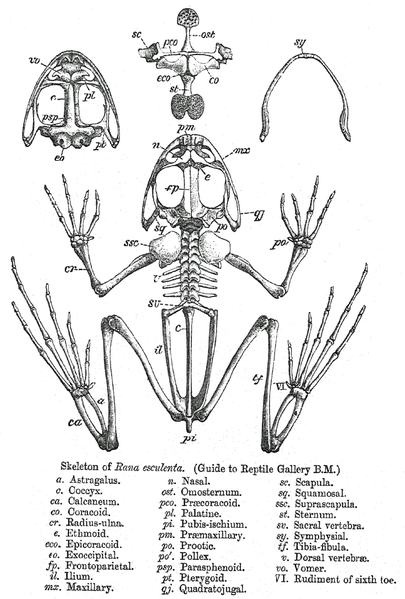Rikcha:Rana skeleton.png

Kay ñawpaq qhawariypa chhikan kaynin: 405 × 599 iñu. Huk huyakukuna: 162 × 240 iñu | 324 × 480 iñu | 723 × 1069 iñu.
Qallariy willañiqi (723 × 1069 iñu; willañiqip chhikan kaynin: 263 kB; MIME laya: image/png)
Willañiqip wiñay kawsaynin
P'unchaw/pacha nisqapi ñit'iy chaypacha willañiqi kachkasqata qhawanaykipaq.
| P'unchaw/Pacha | Uchuylla rikchacha | Chhikanyachikuqkuna | Ruraq | Willapuy | |
|---|---|---|---|---|---|
| kunan | 04:10 1 dis 2005 |  | 723 × 1069 (263 kB) | Shyamal | Skeleton of frog. Rana Boulenger,GA 1890.The fauna of British India including Ceylon and Burma. Reptilia and Batrachia. Taylor and Francis |
Maypim willañiqita llamk'achinku
Kay rikchamanqa kay qatiq p'anqam t'inkimun:
Mayqin wikikunapi willañiqita llamk'achinku
Kay wakin wikikunam willañiqitaqa llamk'achinku:
- als.wikipedia.org-pi kaykunapi llamk'achinku
- ar.wikipedia.org-pi kaykunapi llamk'achinku
- ast.wikipedia.org-pi kaykunapi llamk'achinku
- be.wikipedia.org-pi kaykunapi llamk'achinku
- bg.wikipedia.org-pi kaykunapi llamk'achinku
- ca.wikipedia.org-pi kaykunapi llamk'achinku
- ceb.wikipedia.org-pi kaykunapi llamk'achinku
- chr.wikipedia.org-pi kaykunapi llamk'achinku
- de.wikipedia.org-pi kaykunapi llamk'achinku
- en.wikipedia.org-pi kaykunapi llamk'achinku
- eo.wikipedia.org-pi kaykunapi llamk'achinku
- es.wikipedia.org-pi kaykunapi llamk'achinku
- fr.wikipedia.org-pi kaykunapi llamk'achinku
- gl.wikipedia.org-pi kaykunapi llamk'achinku
- gv.wikipedia.org-pi kaykunapi llamk'achinku
- he.wikipedia.org-pi kaykunapi llamk'achinku
- hy.wikipedia.org-pi kaykunapi llamk'achinku
- li.wikipedia.org-pi kaykunapi llamk'achinku
- lv.wikipedia.org-pi kaykunapi llamk'achinku
- mk.wikipedia.org-pi kaykunapi llamk'achinku
- ml.wikipedia.org-pi kaykunapi llamk'achinku
- oc.wikipedia.org-pi kaykunapi llamk'achinku
- or.wikipedia.org-pi kaykunapi llamk'achinku
- pl.wikipedia.org-pi kaykunapi llamk'achinku
- pt.wikipedia.org-pi kaykunapi llamk'achinku
- ru.wikipedia.org-pi kaykunapi llamk'achinku
- sah.wikipedia.org-pi kaykunapi llamk'achinku
- so.wikipedia.org-pi kaykunapi llamk'achinku
- sr.wikipedia.org-pi kaykunapi llamk'achinku
- sv.wikipedia.org-pi kaykunapi llamk'achinku
- uk.wikipedia.org-pi kaykunapi llamk'achinku


